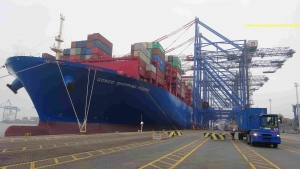Costly CO2 emissions. EUR 8.4 billion by 2026 will be spent by merchant fleet operators

By Marek Grzybowski, BSSC Baltic Maritime Journalist Club
In 2024, the bill for EU ETS regulations will cost maritime transport operators with ships over 500,000. GT around EUR 3 billion. By 2026, maritime transport operators will have to spend EUR 8.4 billion on the EU fee for CO2 emission allowances, informs the Trade Winds portal Benjamin Gibson from Hecla Emissions Management. CO2 emissions will be particularly costly for tanker and container ship operators.
From 1 January 2024, shipping will be covered by the EU Emissions Trading System (ETS). Based on current emissions, Hecla Emissions Management has calculated what the shipping ETS will cost. This will be well over €3 billion in 2024.
Total emissions covered by the ETS for maritime transport amounted to 83.4 million tonnes of CO2 equivalent (tCO2e) in 2022. It was noted that despite the replacement of the fleet and other measures to improve the efficiency of ship propulsion systems, there was a slight decrease in CO2 emissions, only by 0.22% in compared to 2021. At the current market value of EUR, shipping emissions therefore had a total cost of EUR 7.5 billion over one year.
Many consulting companies, operators and shipowners have already calculated how much the operating costs of individual ships and fleets will increase. It was also calculated how the CO2 emission charges would actually translate into the costs of final products.
More than EUR 1 million per year per bulk carrier
– Operating costs of an average 10-year-old bulk carrier emitting approx. tonnes of CO2 per year would increase by EUR 1.3 million in 2026 assuming that it only trades between EU ports. Depending on the basic cost of emission certificates, these costs can increase significantly, calculated Friederike Hesse, co-founder and managing director of Zero44.
Different types of ships have different financial implications due to the different regions they sail in and the different CO2 emission profiles they have, Hesse reserves. In her opinion, the latest EU MRV report analyzing CO2 emissions from maritime transport gives the following picture:
• In 2024, the EU ETS will increase the operating costs of a container ship by an average of PLN 550,000. EUR in 2024 and by EUR 1.4 million in 2026.
• By 2026, bulk carriers whose MRV data shows 15% of intra-EU voyages and 85% of non-EU voyages will have to incur additional operating costs of 260,000. EUR per ship.
• EU ETS will increase tanker operating costs by PLN 380,000. EUR already in 2024 and will increase to EUR 1 million in 2026.
Bimco, Maersk and MSC have calculated
Experts from the Bimco analytical company have proposed a clause in the emissions trading system for time charters. Also, global container ship operators Maersk and MSC have already announced ETS surcharges, which will be included in freight charges and will work across the entire value chain.
A year ago, Maersk stated that “Travel plays a key role in carbon pricing.” The point is that in shipping the concept of travel plays a key role. The company notes that “The Commission’s ETS proposal is about ships, not cargo.” This means that shipping operators will be obliged to purchase allowances for:
– 50% of emissions from voyages departing from an EU port to a non-EU country,
– 50% of emissions from voyages departing from a non-EU port to an EU port,
– 100% of emissions from voyages between EU ports,
– 100% of emissions from ships moored in an EU port.
A year ago, Sebastian Von Hayn, Director of Networks and Markets Asia/EU at A.P. Moller-Maersk, has calculated estimated cost increases (in EUR) for FFE container fees. The cost of transporting a container will increase around EUR 90. But more precisely, on the WCSA service to Europe, it will be EUR 213 (Trade Dry) and EUR 319 (Reefer) and respectively on the routes from Northern Europe to the Far East EUR 99 and EUR 149, on the Far East to Northern Europe route EUR 170 and EUR 255.
Short shipping under price pressure
Operators of smaller fleets announce a significant increase in operating costs after the entry into force of the ETS in 2024. Shipowners operating feeder connections and many operating in short sea shipping services should be particularly taken into account here. And the European Union is keen to transfer land transport, in particular road transport, to the sea.
The importance of connections is demonstrated by the turmoil on Ukraine’s connections with the Mediterranean countries after the blockade of Ukrainian Black Sea ports and the declaration of this region as a high-risk area for maritime transport.
It is therefore possible that small operators will not have the appropriate potential and financial backing to bear the implementation of energy efficiency in a short time. As they mainly operate between EU ports, they are certainly not able to take advantage of fleet-wide emission profile diversification to reduce EU ETS costs.
